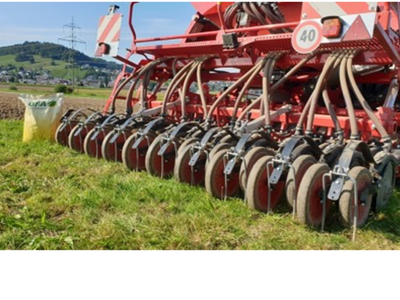Have any questions?
+44 1234 567 890
Cover Crop Banding with high guidance system accuracy: Smart preparation for no-till corn
Objectives:
The aim of the experiment is the smart use of existing mechanization by incorporating the repeatable accuracy of the RTK correction signal. For this purpose, cover crops were sown in strips in the fall of 2020 (cover crop banding). In spring 2021, corn will be planted directly and precisely into the rows left out. In addition to appropriate soil protection, the method aims to eliminate weed control (mechanical and chemical).
What are the advantages of cover crop banding?
Cover-crop banding allows the existing mechanization, such as seed drill and cultivator, to be used in combination with a guidance system with RTK accuracy for an alternative cultivation method. Compared to the offset strip-till method, cover-crop banding saves one pass by eliminating the partial loosening of the soil in the spring. Cover-crop banding, on the other hand, involves intensive loosening over the entire area as early as the fall. The cover crops ensure a high degree of soil cover in winter, which reduces the risk of erosion, promotes biological soil activity and organically binds nutrients so that they are quickly available again for the plants. It is desirable for green manures to emerge as quickly as possible in the fall so that unseeded rows are closed and emergent seed weeds are suppressed. In spring, the use of knife rollers stops the growth of green manure. By using the knife roller for seeding, there is no need for a separate pass. Thus, the cover crop does not compete directly with the corn for water and nutrients. The non-overwintering cover crops freeze standing in the winter and are not brought to the ground in the fall as is usually the case. This prevents a non-decomposed mulch layer that slows soil drying in the spring. The cover crops brought to the ground in spring should cover the soil over a wide area (even in the row) and contribute to weed suppression, so that no herbicide application is necessary.
Study design and applied equipment
The trial takes place in the lower part of the Rütteli plot (figure). After harvesting the previous crop, winter wheat, two cultivator passes took place. The aim of the first cultivator pass was to mix in the harvest residues of the winter wheat. On the other hand, the second cultivator pass was intended to achieve deep loosening (30 cm). Thus, deep tillage can be carried out in the summer under optimal moisture conditions. Deep tillage in spring is often disadvantageous, because then the subsoil often has too high moisture content and the unloosened soil is less likely to freeze out in winter.
Subsequently, four different cover crops were sown with 30 cm wide seed-free strips at regular intervals of 75 cm. Strip seeding was implemented by a clever and easy-to-implement modification to the seeder (row spacing of 15 cm). The four closable outlets of the distribution tower, which are intended for tramlining, were assigned to other sowing coulters and kept constantly closed. As a result, no seed was sown on four sowing coulters over a working width of three meters. In spring 2021, grain corn will then be planted precisely and directly into the 30 cm wide gaps thanks to the use of the guidance system. The guidance system uses an RTK (Real Time Kinematic) correction signal, which is characterized by its high static accuracy. This allows the corn to be planted with centimeter accuracy into the 30 cm wide strips without cover crops. During planting, the knife roller in the front attachment ensures that the overwintering cover crop is rendered incapable of growth. On the planter, row cleaners will remove any cover crop residues from the seed rows.
Results to date and discussion
Two hardy and two freezing cover crop mixtures were sown to determine the differences of freezing and wintering cover crops. Despite the tendency of late sowing time, the green manures UFA Inka, Chinese cabbage turnip and yellow mustard showed a satisfactory emergence rate. Only the emergence of the UFA-Maisfix mixture as green manure was not satisfactory. The reason for this is the temperature requirements of the varieties in the mixture, which are actually optimized for sowing in the warmer spring as cover crop in corn. Drone photographs showed that unfortunately none of the green manures were able to completely close the rows that had been omitted during sowing. As a result, the future corn rows (30 cm wide) did not remain completely weed-free.
CONTACT









